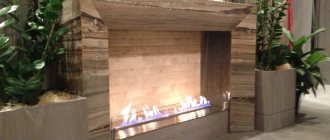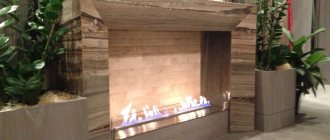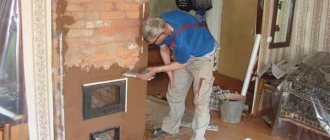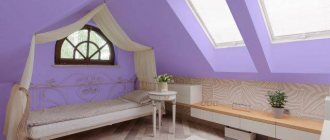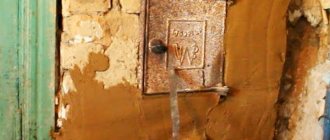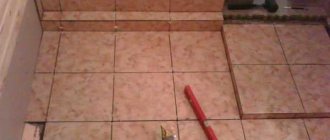During operation, the surfaces of sauna stoves heat up to approximately 400 °C. In this state, they intensively give off heat to the surrounding space. The surfaces are heated. And first of all, the walls that are located in the immediate vicinity of the stove are heated. They are usually made of wood, which begins to char when exposed to high temperatures. This poses a risk of fire. To avoid such troubles, sheet protective materials are used in bathhouses, from which screens and lining are made. In addition to the fact that they must be fireproof, these materials must also provide a certain aesthetics to the room.
Distinctive features
Ceramic tiles are widely used for finishing sanitary rooms in medical and health institutions; rooms for hygiene procedures and kitchen at home. You cannot decorate the surfaces of stoves with such products. Fireproof slabs have their own characteristics. They must meet the following criteria:
increased heat resistance;- possibility of fixation with special adhesives;
- strictly defined ability to absorb moisture, not exceeding 3% by weight of the tile;
- preservation of appearance and performance properties at a significant increase in temperature, including 1500 ℃;
- constancy of qualities under temperature changes from very high positive to negative.
Fireproof tiles for stoves are able to accumulate heat and then slowly release it into the space of the room. The material must be beautiful and hygienic.
There are many finishing slabs for stoves and fireplaces. Manufacturers and suppliers present some of them as heat-resistant. It is advisable to have an idea about fireproof products, the quality of which has been tested in practice by users.
Protective screens for furnaces
Protective screens are structures used to insulate the side walls of furnaces. They reduce thermal radiation. Protective screens are made of brick and steel. Mostly such designs are used for metal furnaces.
Oven with metal protective screen
The easiest way to build a protective screen for a furnace with your own hands is from sheets of cast iron and industrial steel. Such screens are the most common. The sheets are installed at a distance of 1-5 cm from the walls of the oven.
Terracotta and majolica
The leading position is occupied by slabs for stoves called “terracotta”. This trade term implies not only color, but also composition, manufacturing technology, and surface structure.
Refractory products are made from pressed kaolin of special fractions. The surface of terracotta stove slabs is tactilely perceived as pleasantly rough.
The color of the product really has all shades of terracotta, reminiscent of natural stone or familiar brick. Fireproof kaolin boards are primarily intended for stoves in baths and saunas.
Majolica is a name given to slabs made of calcined clay, covered with a kind of glaze on top. Ancient majolica can be seen in museums. This is a work of art. The production of modern types of such refractory slabs also requires rare skill.
Majolica for stoves is made in several stages and painted by hand. It's not cheap. Finishing stoves in this style is a sign of good taste and wealth of the owners. Branded refractory products always require significant financial costs.
Purpose
Burning organic fuel - wood, peat, coal - creates enormous temperatures inside and on the outer surfaces of the stove. Fire regulations provide strict requirements:
- stoves made of ordinary bricks can be located at a distance from the walls exceeding one third of a meter.
- if the stove is made of metal and not finished with special materials (linings), then the minimum distance should be 1 meter;
- The outer surfaces of the stove, protected by a refractory lining, can be located at a shorter distance from the wall than conventional metal ones. The minimum for them is 70 cm.
The wishes of firefighters are not always feasible given the existing sizes and shapes of the home. A way out of this situation can be found by finishing with heat-resistant sheet materials. By enclosing the furnace on all three sides, you can accumulate heat in the resulting space around the furnace without fear of ignition.
Tile and clinker tiles
Classic ceramic tiles are not suitable for finishing stoves. Dense ceramics with a matte surface have a chance to survive at high temperatures.
The glaze on inexpensive products can crack from heating and deteriorate from temperature changes, especially if the air in the room becomes frosty. Conventional fireproof boards can only be laid on stoves using special adhesives or fixed in metal frames.
Clinker tiles are adapted to harsh conditions of use to a much greater extent than conventional ones. Refractory products are obtained by mixing fireclay and shale clays with additional components.
The mixture is fired in a special mode and is not glazed. The result is a very dense slab for decorating stoves, fireplaces and even barbecues. It does not allow water to pass through and does not react to sudden temperature fluctuations.
The basis of decorative compositions often contains brown color. It is obtained by adding mineral pigments.
Changing the amount of natural color leads to the appearance of new shades: from light beige to coffee brown. There are several color variations for refractory clinker tiles in warm colors.
Glass for fireplaces and stoves
Fireproof glass belongs to the category of modern materials. This coating has a number of its own unique characteristics and features, which you need to familiarize yourself with before purchasing.
A fireplace, the glass for which is selected correctly, can withstand heating temperatures reaching 800 degrees. At the same time, the material does not melt and does not change its appearance.
Fireplace glass can have different thicknesses and shapes. Its surface can be smooth, matte, mirror, patterned or grooved. The cost per square meter depends on the manufacturer and varies from 5 thousand rubles and above.
The advantages of tempered fire-resistant glass include low thermal expansion. The most popular and fire-resistant glass is quartz-based glass. It can withstand temperatures up to 1100 degrees.
How to make fireproof glass, watch this video:
The material gains strength through strong and long-term hardening. As a final result, the glass acquires not only heat resistance, but also sound insulation. The coating can be either classic transparent or tinted.
The advantages of tempered glass include:
- Protecting the space from the effects of fire located in the combustion chamber of the fireplace;
- Glass is used not only as fireplace inserts and doors, but also as a decorative, protective flooring under the stove;
- Thermal energy in glass-closed fireboxes can accumulate and accumulate;
- The glass is not exposed to strong heat;
- Good tolerance to heat, high temperatures, and large mass of the object standing on it.
The disadvantages include greater weight and less durability compared to metal and cast iron doors. Many systems are equipped with pyrolysis cleaning, which simplifies maintenance and does not allow soot and soot to settle on the surface.
Tempered glass can be used as inserts in areas of the fireplace where the heating temperature does not exceed 800 degrees. In this case, the space around the combustion chamber can be insulated using tempered glass.
When purchasing and selecting, pay attention to the maximum temperature range for the material, the strength level of the product, thickness, and service life.
Tiles and fireclay tiles
Tiles is a word familiar from fairy tales. This is the name of a special type of refractory plates for furnaces. Tiles are made from clay in the form of boxes. The material is finished with glaze and a pattern on top.
The composition of the raw materials and the unusual shape of the tiles give them the ability to retain heat for a long time. Near the walls of the stoves, panels covered with tiles, craftswomen sat long winter evenings with bobbins and hoops. Fireproof tiles are made by hand and are expensive.
Fireclay tiles for stoves have great resistance to temperature changes, the action of aggressive substances, and mechanical strength. Refractory qualities are due to the composition and high (up to 1200 ℃) firing temperature.
The material is made from highly refractory clay, to which finely dispersed stone raw materials are added. The tile is noticeably different from other types due to its thickness.
Fireclay does not wear out or crack. Even if you accidentally drop a heavy object when laying it on the tiles, the slab will remain intact.
Fireproof materials and methods of their use
Asbestos sheet
Asbestos is a common fireproof material that can withstand prolonged heating up to 450-500 °C. At the same time, it almost does not lose its strength. Asbestos is a material that conducts heat poorly.
It is produced in different forms, including in the form of sheets. Widely used where furnaces are used, for thermal insulation of objects prone to fire, for the construction of fire-resistant walls and ceilings, etc.
Sheet steel
Steel is widely used in furnace production . It is used in different forms (angle, channel, wire, etc.). You can’t do without sheet steel either. Thus, elements of furnaces are made from it, sheets of metal are laid in front of the furnace doors, and it is also used for ovens. In the latter case, the steel must be clean, absolutely free from rust.
Porcelain tiles and stone
Fire-resistant porcelain stoneware slabs are characterized by high durability at relatively affordable prices. The name of the product indicates its composition. Porcelain tiles are made from several types of sand and clay using ground quartz and spar.
Products are colored with inorganic metal compounds: salts and oxides. A fire-resistant porcelain stoneware slab differs from other heat-resistant finishes in the absence of pores, high density, and resistance to high positive and negative temperatures.
Manufacturing technology allows us to produce products that are indistinguishable in appearance from natural stone and other expensive tile materials.
If you have the funds, you can afford to purchase coverings for stoves and fireplaces with heat-resistant tiles made of natural marble. Material, services of designers and installers are expensive. The result is impressive.
Marble slabs are reminiscent of the interiors of palaces of past centuries. The coating is durable and makes a lasting impression.
Fire-resistant artificial stone for stoves has a much more affordable price. Even a not very experienced craftsman can lay it. The slab imitates ordinary stones of different sizes. Therefore, during installation there is no need to strictly select the pattern or monitor the continuation of the surface topography.
Fireproof linoleum
Fireproof linoleum has a visual similarity to the classic coating. Its advantages and features include the presence of a special fire-resistant layer, which ensures a high level of fire safety. The coating tolerates strong heat well and does not ignite or melt when exposed to fire or sparks.
Fireproof linoleum is widely used in the following areas:
- In warehouses;
- In pavilions in markets and trade counters;
- In hospitals and medical centers;
- In hotels, hostels and hotels;
- Restaurants, cafes;
- In industrial buildings;
- Public premises;
- Offices and gyms;
- In entertainment venues.
Non-flammable linoleum has the following properties that you should pay attention to when purchasing:
- Non-flammability and lack of release of various substances and chemicals during combustion and heating;
- Low degree of smoke in the event of a fire in the room;
- Slow flame spread.
Linoleum acquires such characteristics due to its layered structure.
The top layer is a polyurethane film that protects the skin. The previous layer has a purely decorative function. The next layer contains PVC, which distinguishes the product for its quality and strength, fire resistance and wear resistance. Next comes the 4th layer, which is based on fiberglass. It is responsible for protecting the coating from moisture, fungi and other formations. The lowest layer is responsible for sound insulation of the flooring.
What advantages does it have?
Fire-resistant linoleum has the following characteristics:
- The coating has a long service life and is durable;
- It is durable and wear-resistant. Able to last about 30 years;
- Linoleum is hygienic, easy to clean, and any contamination (fats, oils, chemical solvents) can be easily removed from the surface. The composition of the product does not allow the formation of mold and mildew;
- To lay the coating you do not need professional tools or skills. The process does not take much time;
- Large selection of colors, structures, patterns and imitations, at an affordable price of the material;
- It has good antistatic properties. Dust does not form on the surface and dirt does not accumulate.
Mostly non-flammable linoleum is used for buildings and premises that must have a high level of fire safety. This category includes medical institutions, shopping centers, and kindergartens. This coating is also suitable for a room with a stove or wood-burning fireplace.
Before purchasing a material, you must be sure to familiarize yourself with all its characteristics, features and labeling. For this purpose, quality certificates are studied.
What are the criteria for choosing fireproof materials for walls?
When selecting material, you should consider the following features:
- type of premises - residential or non-residential, in the first case it is better to buy “fine” samples;
- fuel for a stove or fireplace - the temperature to which the firebox will heat up depends on it;
- cost - the price of materials also matters, you should familiarize yourself with it in advance;
- manufacturer - it is better to choose branded products that meet all GOST standards.
When selecting, it is advisable to be guided by all points, this will help you make a rational decision. High-quality refractories for stoves or fireplaces undergo careful production control, which ensures their reliability. The sheathing of the area is carried out strictly before installation or assembly, which ensures compliance with safety regulations.
Types of fire resistant sheets
The vast majority of fire-resistant sheet materials are made from natural or converted natural minerals. This is quite understandable. The minimum temperature that non-combustible fences must withstand exceeds 1500 ℃.
It is difficult to imagine a polymer structure that can survive such a load. The fire resistance limit of plastics is much less.
Effective protection will be provided by the installation of fire-resistant corrugated sheets. You can place additional thermal insulation between it and the furnace wall. To avoid the release of metal oxidation products into the room, you should opt for fire-resistant stainless steel products.
You can increase the thermal protection of walls by polishing the metal surface. Smooth sheet metal will be able to better reflect the energy of heat rays and protect walls from overheating.
Asbestos
You can still often find recommendations for the use of fire-resistant asbestos boards and sheets. Yes, asbestos guarantees a fire-fighting effect to a greater extent than many other materials. However, one should not forget about the danger of microscopic asbestos fibers entering the respiratory tract.
The most durable pressing of sheet products cannot completely eliminate this. Manufacturers inform that the asbestos-cement base is hermetically sealed on both sides with additional layers.
However, when working, the sheet material must be cut. In the sections, the end parts are exposed. It is advisable not to take risks and choose other fire-resistant products for residential premises that do not have any disadvantages.
Basalt
Basalt sheet materials demonstrate good thermal and sound insulating properties in practice. The crackling of logs sometimes creates a romantic mood, but the constant sounds from the stove can be annoying. Basalt absorbs both heat and sound waves. Residents are ensured that there is no noise or risk of fire.
Vermiculite and mineralite
To a large extent, fire-resistant qualities are characteristic of vermiculite sheet materials. This complex composition of magmatic origin has an evolutionarily developed resistance to high temperatures.
By the way, fire-resistant properties are inherent in all materials of volcanic origin for obvious reasons. In addition to sheet material, vermiculite chips are popular.
An interesting relatively new refractory product is mineralite, which, in fact, is a composite of long-known cement, cellulose fibers and mineral additives. Minerite is often called fiber cement. It is absolutely harmless. The reliability and durability of mineralite sheet material has been proven.
Glass fibers
Sheets made from special types of tempered glass can withstand high temperatures well. Drywall is reinforced with glass fibers. By adding magnesium oxides to the fibrous glassy components, fire-resistant boards are made.
Fiberglass sheet materials have gained popularity among consumers over many years of operation.
